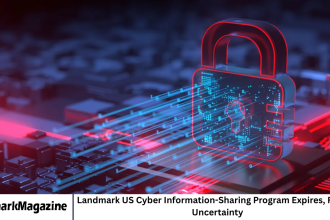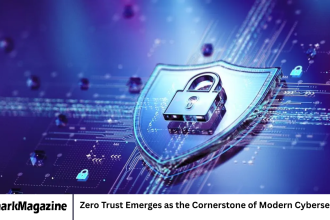Cybersecurity experts have identified a new and dangerous strain of ransomware named Yurei, which has been rapidly spreading across networks by exploiting SMB (Server Message Block) shares and removable drives. Once it infects a system, Yurei encrypts all accessible files and demands ransom payments in exchange for decryption keys.
- How Yurei Ransomware Operates
- SMB Shares: A Key Attack Vector
- Exploitation Through Removable Drives
- Encryption and Ransom Demand
- Detection and Removal Challenges
- Preventive Measures and Mitigation
- Network Segmentation
- Regular Software Updates
- Endpoint Protection
- Backup and Recovery Planning
- User Education
- Response After Infection
- Broader Implications for Cybersecurity
- Frequently Asked Questions
- Conclusion
Unlike many ransomware variants that rely primarily on phishing or remote exploits, Yurei uses local network connections and portable media to propagate, making it especially challenging to contain within large organizations. Its ability to spread silently through shared folders and external devices has made it a growing concern for both businesses and individuals.
How Yurei Ransomware Operates
Yurei ransomware begins its attack by infiltrating a host system, typically through a compromised executable file or malicious installer. Once executed, it installs itself deep within the system, often disguising its presence under legitimate-sounding process names.
After installation, Yurei performs a system scan to identify accessible network shares and connected devices. It then leverages the SMB protocol, which is commonly used for file sharing across local networks, to copy itself to other computers. In environments where file sharing is heavily used, this method allows Yurei to spread with alarming speed.
If removable drives such as USB sticks or external hard drives are connected, Yurei copies its payload onto them as well. When these infected devices are plugged into another system, the ransomware activates automatically, continuing the cycle of infection.
Once the spread phase is complete, Yurei encrypts files on both the local and connected drives using strong cryptographic algorithms. Victims are then presented with a ransom note demanding payment—usually in cryptocurrency—in exchange for decryption keys.
SMB Shares: A Key Attack Vector
The use of SMB shares as an infection vector makes Yurei particularly effective in corporate and institutional environments. Many organizations rely on SMB for internal collaboration and data storage, often leaving shared drives accessible to multiple users.
If one computer within a network is compromised, Yurei can easily traverse shared folders to infect additional systems. Even in cases where administrative permissions are restricted, the ransomware can exploit weak credentials or misconfigured access rights to spread.
Experts warn that once Yurei gains a foothold, it can compromise an entire network in a matter of minutes. This makes early detection and containment crucial to minimizing damage.
Exploitation Through Removable Drives
Yurei’s use of removable drives as a propagation mechanism gives it the ability to jump between isolated systems—an ability that many modern ransomware variants have lost.
When a USB drive or external hard disk connected to an infected system is later plugged into another computer, the ransomware automatically executes, encrypting files and replicating itself again.
This infection strategy is reminiscent of older malware like Conficker and WannaCry, which spread rapidly across both connected networks and portable media. However, Yurei’s encryption capabilities make it far more destructive.
Organizations that rely on portable storage for data transfers are particularly at risk if proper endpoint protection and scanning policies are not in place.
Encryption and Ransom Demand
Once Yurei completes its spread, it begins the encryption process. It targets a wide range of file types including documents, spreadsheets, images, and databases. Each encrypted file is renamed with a unique extension, and a ransom note is placed in every affected directory.
The ransom note typically contains instructions for contacting the attackers via an anonymous email address or messaging platform, along with a demand for payment in Bitcoin or Monero. The attackers claim that victims will receive a decryption key after payment, although there is no guarantee that this will occur.
Experts strongly advise against paying the ransom, as doing so not only funds further criminal operations but also provides no assurance that files will be restored.
Detection and Removal Challenges
Yurei’s stealth and adaptability make it difficult to detect before encryption begins. The ransomware avoids detection by terminating system processes related to antivirus and backup software. It also deletes shadow copies of files, preventing users from recovering data through standard Windows recovery tools.
Security researchers note that Yurei often operates silently in the background for several hours before triggering encryption, using this time to identify network connections and maximize its spread.
For detection and response teams, this delayed activation means that by the time encryption starts, multiple systems may already be compromised.
Preventive Measures and Mitigation
Preventing Yurei ransomware infections requires a multi-layered security approach. The following measures can significantly reduce the risk of infection and limit potential damage:
Network Segmentation
Organizations should segment their networks to prevent unrestricted access between systems. Limiting the use of SMB shares and implementing strict access controls can reduce the potential spread of ransomware.
Regular Software Updates
Keeping operating systems and applications up to date ensures that known vulnerabilities are patched, reducing the chances of exploitation by ransomware or other malware.
Endpoint Protection
Modern endpoint security solutions equipped with behavioral detection and intrusion prevention features can identify suspicious activity associated with ransomware, such as unauthorized encryption or file modification.
Backup and Recovery Planning
Maintaining regular, offline backups is essential. Backups should be stored on systems not directly connected to the network, ensuring they remain safe from infection.
User Education
Employees and users should be trained to recognize suspicious files, avoid running unknown executables, and safely handle removable drives.
Response After Infection
If Yurei ransomware successfully infects a system, immediate action is critical. The infected machine should be isolated from the network to prevent further spread. All removable drives and shared folders should also be disconnected.
Incident response teams should collect forensic data to understand the scope of the attack and identify patient zero — the first compromised system. Backups should be used for recovery once the threat is completely eradicated.
Victims are advised to report incidents to cybersecurity authorities and not engage directly with the attackers. In many cases, decryption tools may eventually be developed by security researchers and released publicly.
Broader Implications for Cybersecurity
The emergence of Yurei ransomware highlights a troubling evolution in cybercrime tactics. While many ransomware operations have shifted to phishing and remote exploits, Yurei’s reliance on local network protocols and removable drives shows that old attack methods can still be highly effective when combined with modern encryption.
This resurgence of self-propagating ransomware indicates that organizations must remain vigilant across all attack surfaces, not just email and web vectors. Hybrid work environments, where employees use both corporate and personal devices, further increase the risk of cross-system infection.
Frequently Asked Questions
What is Yurei ransomware?
Yurei is a newly discovered ransomware strain that spreads through SMB shares and removable drives, encrypting files and demanding payment for decryption.
How does Yurei spread between systems?
It propagates across local networks via SMB file-sharing protocols and copies itself to removable drives like USBs and external hard disks.
What happens after infection?
Once a system is infected, Yurei encrypts files, adds unique extensions, and leaves a ransom note demanding cryptocurrency payment.
Can antivirus software stop Yurei?
Some advanced antivirus and endpoint protection tools can detect Yurei’s activity, but its stealth mechanisms make early detection challenging.
Should victims pay the ransom?
Experts strongly advise against paying, as attackers may not provide decryption keys and paying encourages further criminal activity.
How can organizations protect against Yurei?
They should segment networks, limit SMB access, use updated antivirus solutions, maintain offline backups, and train staff on cybersecurity awareness.
Is data recovery possible after infection?
Data recovery may be possible using offline backups or future decryption tools released by cybersecurity researchers. However, prevention remains the best defense.
Conclusion
The Yurei ransomware campaign serves as a stark reminder that cybersecurity threats continue to evolve, combining traditional techniques with advanced encryption to cause widespread damage.
Its ability to spread through SMB shares and removable drives makes it uniquely dangerous, particularly for businesses with interconnected systems. Preventing such attacks requires robust security measures, continuous monitoring, and well-practiced incident response strategies.









